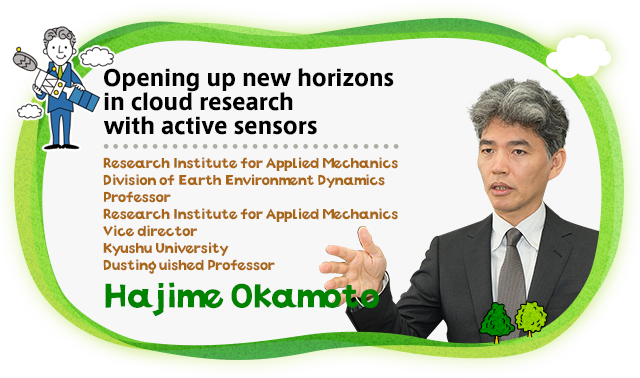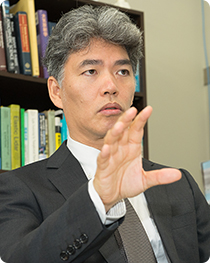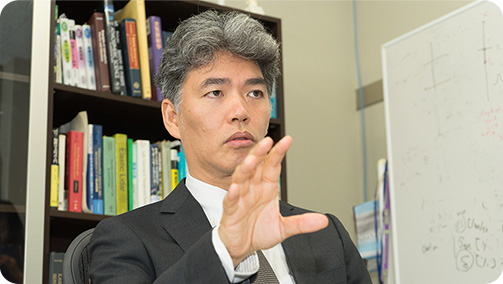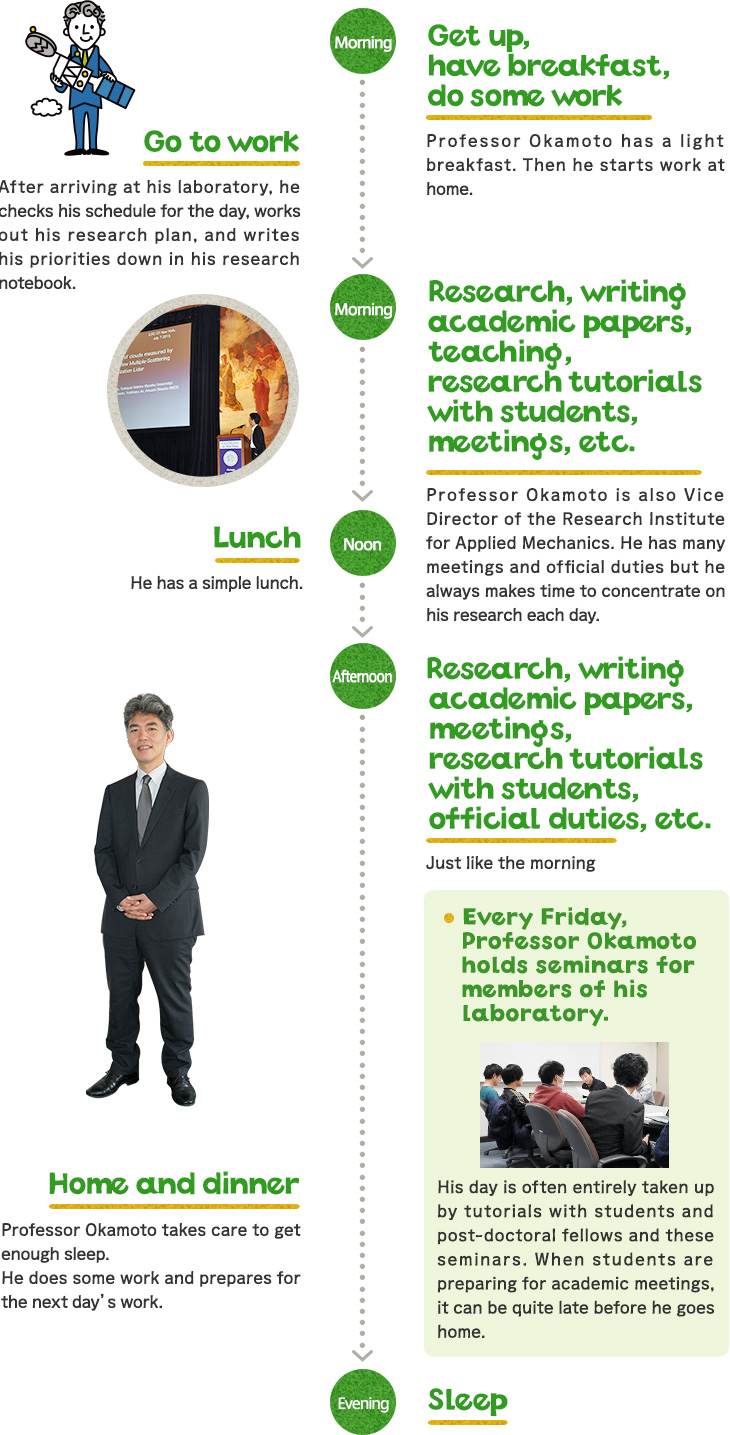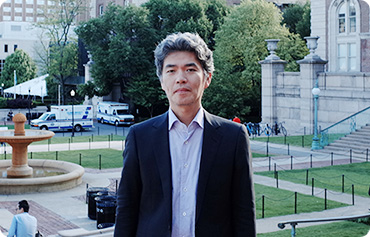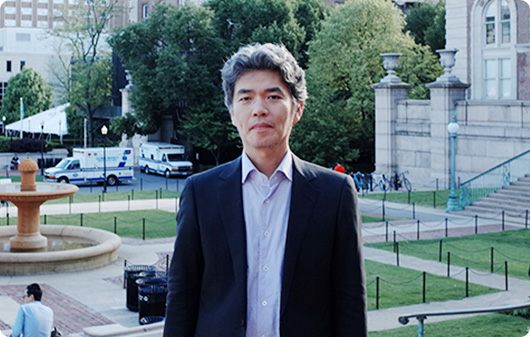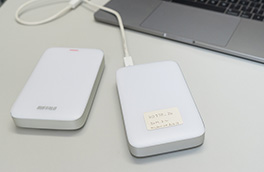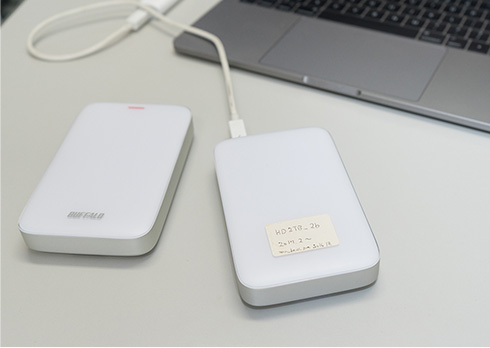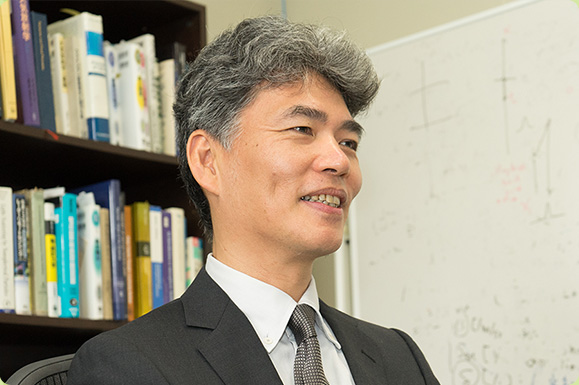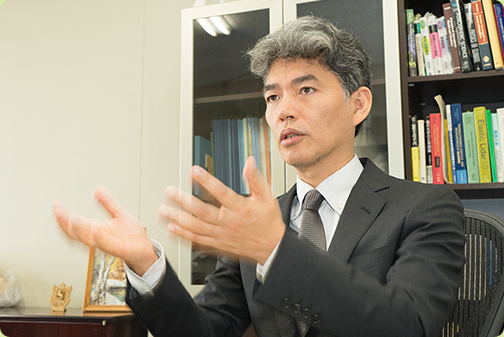 Professor Okamoto patiently answered to each question in a gentle manner.
Professor Okamoto patiently answered to each question in a gentle manner.
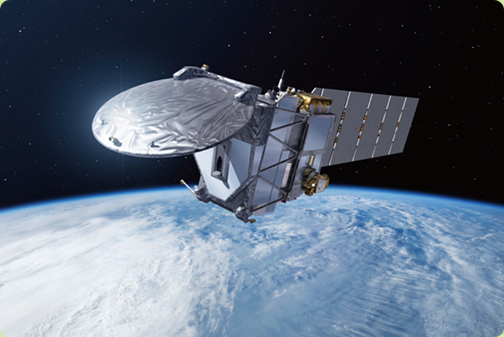 The EarthCARE satellite due for launch in 2019. It is equipped with functions to measure movements that conventional satellites could not measure, that will able to derive the macroscale and microphysical properties of clouds, aerosols and precipitation and measure the upward and downward movements of air with greater precision. (Image provided by ESA)
The EarthCARE satellite due for launch in 2019. It is equipped with functions to measure movements that conventional satellites could not measure, that will able to derive the macroscale and microphysical properties of clouds, aerosols and precipitation and measure the upward and downward movements of air with greater precision. (Image provided by ESA)
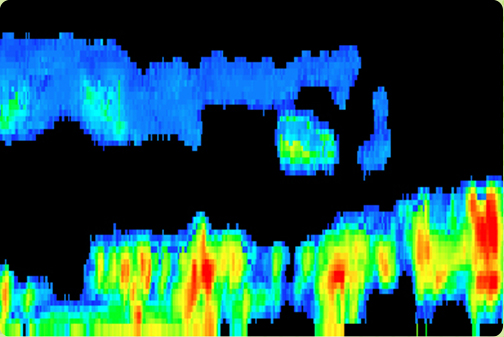 A simulation of the observational data expected to be obtained using the EarthCARE satellite's cloud radar equipped with a Doppler function. This shows the latitude-height cross-section of the Doppler velocity inside a cloud.
A simulation of the observational data expected to be obtained using the EarthCARE satellite's cloud radar equipped with a Doppler function. This shows the latitude-height cross-section of the Doppler velocity inside a cloud.
 Professor Okamoto patiently answered to each question in a gentle manner.
Professor Okamoto patiently answered to each question in a gentle manner.
We use lidar —that uses laser light with ultraviolet, visible light, and infrared wavelengths — and millimeter-wave radar to observe clouds and tiny atmospheric particles called aerosols in order to investigate the global three-dimensional distribution of their physical properties (such as particle size and mass). Understanding the characteristics of clouds and aerosols will lead to better predicting of how global climate systems will change over the decade or more. The mechanism of how clouds affect the climate systems still isn't fully understood. Clouds are regarded as the largest source of uncertainty in climate change projections.
Let me give you a simple explanation of the process that leads to the generation and dissipation of clouds. First of all, aerosols suspended in the atmosphere acts as cloud condensation nuclei for water vapour. They are tiny — just 0.0005 mm or so. As small aerosol particles in the air are caught by updrafts and carried higher into the atmosphere, water vapor condenses upon them, turning them into cloud particles around 0.01 mm in size — more than 100 times bigger than the original aerosol. As they fall, they collide and merge with cloud particles of different sizes, eventually forming precipitaion particles of 0.5 mm or more. These fall to the ground and eventually dissipate.
 The EarthCARE satellite due for launch in 2019. It is equipped with functions to measure movements that conventional satellites could not measure, that will able to derive the macroscale and microphysical properties of clouds, aerosols and precipitation and measure the upward and downward movements of air with greater precision. (Image provided by ESA)
The EarthCARE satellite due for launch in 2019. It is equipped with functions to measure movements that conventional satellites could not measure, that will able to derive the macroscale and microphysical properties of clouds, aerosols and precipitation and measure the upward and downward movements of air with greater precision. (Image provided by ESA)
Some clouds are made from liquid water, while others are composed of solid ice. In mid-latitudes, liquid water clouds are found in warm lower layers at comparatively low altitudes of 4,000 m or less from the earth's surface. Clouds formed at higher altitudes tend to be composed of ice particles. Low-level clouds mainly have a cooling effect on Earth, while upper-level clouds have either a warming or a cooling effect, depending on their properties. These are called cloud radiation effects; their maginitude and sign are determined by whether the cloud particles are ice or water, the height at which the cloud exists, and the size and mass of the constituent particles. Their properties change with time, their location and the season. The generation and dissipation mechanisms of clouds are highly complex. That is why prediction of clouds is difficult.
 A simulation of the observational data expected to be obtained using the EarthCARE satellite's cloud radar equipped with a Doppler function. This shows the latitude-height cross-section of the Doppler velocity inside a cloud.
A simulation of the observational data expected to be obtained using the EarthCARE satellite's cloud radar equipped with a Doppler function. This shows the latitude-height cross-section of the Doppler velocity inside a cloud.
In the early 1980s, efforts to use satellites to observe clouds got underway using passive sensors that used sunlight as a light source or natural thermal radiation. While these helped to study the horizontal distribution of clouds, information about their height remained unclear. In contrast, active sensors emit electromagnetic waves, measure the time interval between the emitted pulse and the reflected pulse from cloud particles. By converting this into range from the instrument to the cloud, we can get information about its height. There were also limitations — from the time I first started my research in 1993, I felt that it was impossible to obtain both the size and the mass of cloud particles using a single wavelength alone. When I faced this issue again in 1998, I eventually started to think that we could simultaneously estimate the mass and size of cloud particles if we used instruments with two completely different wavelengths, i.e., radar and lidar. If the relationship between wavelength and particle size changes substantially, the charactersitics of the scattering also change considerably so that information from radar and lidar can be recognized as independent ones. I think that my experience of investigating the theory of light scattering from the time I was a graduate school planetary science researcher led to these ideas.
I recall that there were many negative opinions about this idea in the begining, but I carried out simultaneous observation of clouds using both terrestrial cloud radar and lidar, and succeeded in retrieving the particle size of ice clouds and their mass per unit mass. Gradually, this synergetic approach became accepted. In 2006, two earth observation satellites — each carrying cloud radar and lidar instrument — were launched in the U.S.A. and I was involved as a member of the satellite program science team. Using these satellites, I was able to prepare simultaneous observation data and analyze the three-dimensional global characteristics of microphysical properties of ice clouds for the first time by applying the synergestic retrieval algorithm. The data that we produced from this analysis in our laboratory was delivered to research institutes around the world and is used in climate change research. The forthcoming satellite, EarthCARE, is a joint Japanese and European mission and is scheduled to be lunched in 2019. It will carry next generation active sensors i.e., a cloud radar with a Doppler function that will reveal movements within clouds, and a lidar system equipped with more advanced functions than ever before. As a mission co-chair, I lead the collaboration of the Japanese and European researchers involed for the success of the mission. In our laboratory, we are also developing new ground-based instruments that simulates satellite signals, to verify the satellite observations. This next generation satellite and new instruments will make it possible to carry out much more detailed information than before including physical properties such as types of cloud and aerosols, the mass and size of cloud particles, and particle fall velocity, as well as upward and downward movements of air within clouds. If we make progress with our analysis, I believe that we can expect new insights into climate change projection research.


Research involves a lot of trial and error until you get results. Really useful ideas only occurs once every few years. The idea about the new technique that I described earlier probably occurred to me because I had been continuously thinking about it. Research is attractive when ones original thoughts come out as scientific or technological outcomes or lead to scientific discoveries. The EarthCARE mission is an immense project and has a long history —at least 17 years — involving hundreds of researchers and engineers. Even so, I believe that the creativity of individuals is absolutely crucial. The real efforts and fun will come after the launch of the satellite, but I'm already thinking about the next satellite program and what kind of observation instruments would be better in the future.
When climate change projections are improved by EarthCARE, I believe that more accurate international discussions about the relationship between climate change and human activity will become possible. Another major motivation of my research is the close relationship between basic research and the real world.

![]()




